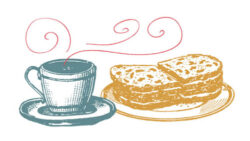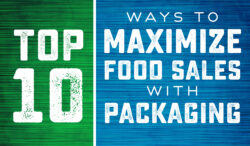Products put up with a lot both in getting to and being on the retail shelf. They are subject to scrutiny in the store buyer’s eye (needing to meet merchandising requirements), jostling in transit, and handling by consumers once on display. All the while the packaging needs to look great and protect the product. How do you develop packaging for maximum performance? Here is a list of 10 things to avoid in retail packaging.
1. Things that can get damaged: flaps, hangtags, decorations.
Use these elements judiciously and sparingly, and make sure they are designed to minimize any signs of wear and tear. You don’t want your product looking shabby by the time it arrives at the store for merchandising, and neither does your store buyer.
2. Crumbs showing at bottom of package.
If your product results in crumbs at the bottom of its container, you definitely want to hide those if at all possible. If printing on a clear pouch, include solid color at the bottom of the pouch to cover it up. For die-cut windows, make sure they are high enough up to not show any crumbs.
3. Containers that aren’t stackable.
Smaller products should definitely be stackable otherwise they’ll result in too much empty space above it on the shelf. Alternatively, smaller products that aren’t stackable can be contained in a stackable bigger container, such as a POP (point-of-purchase) merchandising box. Larger products that maximize shelf height don’t need to be as concerned with being stackable.
4. Containers with too much empty space.
Consumers will be disappointed when they open the package to see the product not filling out the inside dimensions of the container. However, additional space is expected in some package structures such as a tent-top box where it’s not possible to have the product fill out the triangular top shape. Store buyers don’t want disappointed consumers and neither do you.
5. Hard-to-assemble structures.
You may be inclined to save money on structures that have lower cost but require more assembly effort, especially if your volume is low to start. However, as your business takes off you don’t want to be constrained by too much manual labor required in assembling packages. Better to do things right the first time and opt for ease of use.
6. Containers that take up too much space on the retail shelf.
Take a look at what comparable product sizes are for the category you’ll be merchandising in, and follow suit. Buyers want products that fit in easily on their shelf and want to maximize their available space.
7. Packaging that isn’t tamper-evident.
Consumers are curious—they’ll open a package before buying if they can, to inspect it further. However, no one wants to buy a package that’s obviously been opened already. If you want consumers to be able to open and inspect your product then design the package in a way that can easily be re-closed without looking tampered with. If you don’t want the consumer to open the package then make sure to include a tamper-evident feature or safety seal so it’s clear they’re not supposed to open it before purchasing.
8. Die cuts that affect structural integrity.
When you have a die cut in your package to show product, always make sure it is designed in a way that doesn’t weaken the structure. Margins around the die cut should be sufficient to maintain strength and not cause the package to bow out.
9. Labels that don’t show enough product.
If your container shows product through and has a label applied for the packaging, be sure you’re still revealing enough product around the label so that the product can clearly be seen from the front of the package. Consumers like to see product when possible, as it’s the best way to see the quality, and it’s enticing to show that through on the front of the package.
10. Labels that don’t allow enough tolerance.
If your container has a specified labeling area, make sure its label size allows for enough wiggle room during application. Your co-packer can tell you the tolerance of the container, or if applying by hand just subtract a little from your labeling area size.





